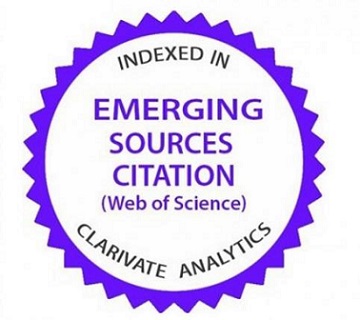Gender Estimation by Using Machine Learning Algorithms with Parameters Obtained from Direct Hand Graphs
DOI:
https://doi.org/10.58600/eurjther2657Keywords:
Hand, X-ray, machine learning algorithms, gender estimationAbstract
Objective: This study was conducted to make gender estimation with parameters obtained from direct hand graphs by using machine learning (ML) algorithms, which is a current issue in the field of health.
Methods: The study was conducted by retrospectively examining the X-ray images of 132 men and 126 women between the ages of 18 and 65 who had not undergone hand surgery or who did not have any pathologies in their hands. Proximal phalanx I length (PPI), distal phalanx I length (PDI), proximal phalanx V length (PP5), medial proximal phalanx V length (PM5), distal phalanx V length (PD5), metacarpal I length (M1) and metacarpal V length (M5) were measured on the images. Gender estimation was made by using the measurements obtained at the input of ML models.
Results: All the parameters obtained were found to be longer and significant in men when compared with women (p<0.05). In gender estimation with ML models, 0.88 Acc rate was obtained with Extra Tree Classifier algorithm and Acc rate of other algorithms was found to vary between 0.79 and 0.87.
Conclusion: As a result of the study, parameters obtained from X-ray hand graphs were found to have highly accurate gender estimation with ML algorithms. In cases where the identity of individuals needs to be predicted quickly and accurately, the analysis of hand radiographs obtained from X-rays and ML algorithms shows that the prediction time can be minimized and high accuracy can be achieved.
Metrics
References
Alunni-Perret V, Staccini P, Quatrehomme G. (2003). Reexamination of a measurement for sexual determination using the supero-inferior femoral neck diameter in a modern European population. Journal of forensic sciences. 48(3);517–520.
Ozaslan A, Işcan MY, Ozaslan I, Tuğcu H, Koç S. (2003). Estimation of stature from body parts. Forensic science international. 132(1):40–45. https://doi.org/10.1016/s0379-0738(02)00425-5
Steyn M, Işcan MY. (2008). Metric sex determination from the pelvis in modern Greeks. Forensic science international. 179(1):86.e1–86.e866. https://doi.org/10.1016/j.forsciint.2008.04.022
Giurazza F, Schena E, Del Vescovo R, Cazzato RL, Mortato L, Saccomandi P, Paternostro F, Onofri L, Zobel BB. (2013). Sex determination from scapular length measurements by CT scans images in a Caucasian population. Annual International Conference of the IEEE Engineering in Medicine and Biology Society. IEEE Engineering in Medicine and Biology Society. Annual International Conference. 2013:632–1635. https://doi.org/10.1109/EMBC.2013.6609829
Öner S, Turan M, Öner Z. (2021). Estimation of Gender by Using Decision Tree, a Machine Learning Algorithm, With Patellar Measurements Obtained From MDCT Images. Med Records. 3(1):1-9. https://doi.org/10.37990/medr.843451
Dayal MR, Bidmos MA. (2005). Discriminating sex in South African blacks using patella dimensions. Journal of forensic sciences. 50(6):1294–1297.
Bhardwaj R, Nambiar AR, Dutta D. (2017). A Study of Machine Learning in Healthcare, 2017 IEEE 41st Annual Computer Software and Applications Conference (COMPSAC), Turin, Italy, 236-241. https://doi.org/10.1109/COMPSAC.2017.164
Secgin Y, Oner Z, Turan MK, Oner S. (2022). Gender Prediction with the Parameters Obtained from Pelvis Computed Tomography Images and Machine Learning Algorithms. Journal of the Anatomical Society of India. 71(3):204-209. https://doi.org/10.4103/jasi.jasi_280_20
Krems R. (2019) Bayesian machine learning for quantum molecular dynamics. Phys. Chem. Chem. Phys. 21:13392-13410.
Chikara RK, Ko LW. (2020). Prediction of Human Inhibition Brain Function with Inter-Subject and Intra-Subject Variability. Brain sciences. 10(10):726. https://doi.org/10.3390/brainsci10100726
Mishra G, Sehgal D, Valadi JK. (2017). Quantitative Structure Activity Relationship study of the Anti-Hepatitis Peptides employing Random Forests and Extra-trees regressors. Bioinformation. 13(3):60–62. https://doi.org/10.6026/97320630013060
Secgin Y, Oner Z, Turan MK, Oner S. (2021). Gender prediction with parameters obtained from pelvis computed tomography images and decision tree algorithm .Turk J Vasc Surg. 10(2):356-361. https://doi.org/10.5455/medscience.2020.11.235
du Jardin P, Ponsaillé J, Alunni-Perret V, Quatrehomme G. (2009). A comparison between neural network and other metric methods to determine sex from the upper femur in a modern French population. Forensic science international. 192(1-3):127.e1–127.e1276. https://doi.org/10.1016/j.forsciint.2009.07.014
Kim DI, Kwak DS, Han SH. (2013). Sex determination using discriminant analysis of the medial and lateral condyles of the femur in Koreans. Forensic Science International. 233:121-125. https://doi.org/10.1016/J.FORSCIINT.2013.08.028
Mahfouz M, Badawi A, Merkl B, Fatah EEA, Pritchard E, Kesler K, Moore M, Jantz R, Jantz L. (2007) Patella sex determination by 3D statistical shape models and nonlinear classifiers. Forensic science international. 173:161-170. https://doi.org/10.1016/J.FORSCIINT.2007.02.024
Akhlaghi M, Bakhtavar K, Bakhshandeh H, Mokhtari T, Farahani MV, Parsa VA, Mehdizadeh F, Sadeghian MH. (2017). Sex determination based on radiographic examination of metatarsal bones in Iranian population. International Journal of Medical Toxicology & Forensic Medicine. 7:203-208. https://doi.org/10.22037/ijmtfm.v7i4(Autumn).17059
Lin C, Jiao B, Liu S, Guan F, Chung NE, Han SH, Lee UY. (2014). Sex determination from the mandibular ramus flexure of Koreans by discrimination function analysis using three-dimensional mandible models. Forensic Science International. 236:191.e1-191.e6. https://doi.org/10.1016/j.forsciint.2013.12.015
Kim DI, Kim YS, Lee UY, Han SH. (2007). Sex determination from calcaneus in Korean using discriminant analysis. Forensic Science International. 228(1-3):177.e1-7. https://doi.org/10.1016/j.forsciint.2013.03.012
Senol D, Bodur F, Secgın Y, Bakıcı RS, Sahin NE, Toy S, Öner S, Oner Z. (2023). Sex prediction with morphometric measurements of first and fifth metatarsal and phalanx obtained from X-ray images by using machine learning algorithms. Folia morphologica. 82(3):704–711. https://doi.org/10.5603/FM.a2022.0052
Turan MK, Oner Z, Secgin Y, Oner S. (2019). A trial on artificial neural networks in predicting sex through bone length measurements on the first and fifth phalanges and metatarsals. Computers in biology and medicine. 115:103490. https://doi.org/10.1016/j.compbiomed.2019.103490
Marouf M, Siddiqi R, Bashir F, Vohra B. (2020) Automated hand x-ray based gender classification and bone age assessment using convolutional neural network. 2020 3rd International Conference on Computing, Mathematics and Engineering Technologies (iCoMET). IEEE:pp 1-5. https://doi.org/10.1109/iCoMET48670.2020.9073878
Nasipuri M. (2023) Human Gender Classification Based on Hand Images Using Deep Learning. Artificial Intelligence: First International Symposium, ISAI. 2022:17-22, Revised Selected Papers. Springer Nature, p 314. https://doi.org/10.1007/978-3-031-22485-0_29
Abdelaal GMM, Abdallah EAA, Alshamy A, Megahed EE. (2022) Adult Sex Discrimination Using Metric Measurements of Hand Digital Radiographs in Egyptian Population. Forensic Medicine and Anatomy Research. 10:27-43.. https://doi.org/10.4236/fmar.2022.102004
Senol D, Secgin Y, Duman BS et al. (2023). Sex and age estimation with machine learning algorithms with parameters obtained from cone beam computed tomography images of maxillary first molar and canine teeth. Egypt J Forensic Sci. 13:27. https://doi.org/10.1186/s41935-023-00346-1
Carriquiry A, Hofmann H, Tai XH, Vander Plas S. (2019) Machine learning in forensic applications. Significance. 16:29-35. https://doi.org/10.1111/j.1740-9713.2019.01252.x
Qadir S, Noor B. (2021). Applications of Machine Learning in Digital Forensics. 2021 International Conference on Digital Futures and Transformative Technologies (ICoDT2). 1-8. https://doi.org/10.1109/ICoDT252288.2021.9441543
Udayangani HPGD, Weerakoon BS. (2022). Gender Determination Using Anthropometric Parameters of Metacarpals and Phalanges on Hand Radiographs. International Journal of Pharmaceutical Research and Allied Sciences. 11(2):29-35. https://doi.org/10.51847/cPVDw0CuEj
Sandra YOG, Ominde BS, Igbigbi PS. (2022). A retrospective radiological study on the morphometry of hand digits and phalanges: role in sex determination. J Krishna Inst Med Sci Univ. 11(2):46-61.
Ozsoy T, Oner Z, Oner S. (2019) An attempt to gender determine with phalanx length and the ratio of phalanxes to whole phalanx length in direct hand radiography. Medicine. 8: 692-697. https://doi.org/10.5455/medscience.2019.08.9074
El Morsi DA, Al Hawary AA. (2013). Sex determination by the length of metacarpals and phalanges: X-ray study on Egyptian population. Journal of forensic and legal medicine. 20(1):6–13. https://doi.org/10.1016/j.jflm.2012.04.020
Downloads
Published
How to Cite
License
Copyright (c) 2025 European Journal of Therapeutics

This work is licensed under a Creative Commons Attribution-NonCommercial 4.0 International License.
The content of this journal is licensed under a Creative Commons Attribution-NonCommercial 4.0 International License.


















